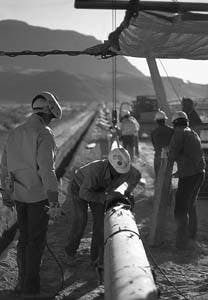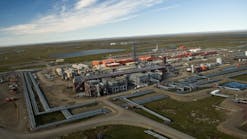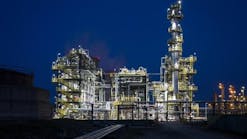Warren R. True
Pipeline/Gas Processing Editor
In a project with major supply implications for petroleum markets in the U.S. Southwest and Mexico, products began flowing last month through a new pipeline from an expanded refinery in the Texas Panhandle to a new storage terminal near El Paso.
Diamond Shamrock Inc., San Antonio, has built the 409 mile, 10.75-in. OD line from its refinery north of Amarillo at McKee, across southeastern New Mexico, and into a new 500,000-bbl tank farm east of El Paso (Fig. 1)(30062 bytes). First shipments of gasoline arrived at the terminal on Nov. 10.
Using one intermediate pump station, Phase 1 of the project has installed 27,000 b/d of capacity from the refinery to the tank farm. With seven more pump stations envisioned, ultimate capacity of the line will be 60,000 b/d.
As part of the project, processing capacity at the McKee refinery has been increased from 120,000 b/sd in 1992 to the current 140,000 b/sd. The increase has resulted primarily from de-bottlenecking the plants crude units.
Diamond Shamrock says major capital expenditures have been required to produce the reformulated gasoline and desulfurized diesel for El Paso now and Tucson and Phoenix later.
At the delivery end of the new pipeline is a 160-acre tank farm consisting of 10 tanks with 500,000 bbl storage capacity, largest of the companys 15 terminals.
The company has refused to release cost data for the expansion at McKee, the 409-mile pipeline, the El Paso terminal, or any other project.
At the end of 1994, however, Diamond Shamrock Pipeline Co., a federally regulated interstate common carrier and wholly owned subsidiary of Diamond Shamrock Refining & Marketing Co., listed nearly $8.8 million in construction work in progress.
Diamond Shamrock Refining & Marketing Co. operates the new pipeline for owner Diamond Shamrock Pipeline.
And for 1994, that company showed $25.4 million in expenditures for new construction and improvements, including $12.1 million spent for pipeline construction.
These data were reported to the Federal Energy Regulatory Commission for calendar year 1994.
Markets
Company officials point out Diamond Shamrocks already large retail presence in El Paso that has grown in the past 5 years.
Officials declined, however, to specify daily volumes of products the company had been shipping into El Paso before the pipeline and terminal were built. They say that the area presents potential markets for turbine and other diesel products.
From El Paso, the company envisions moving aggressively into Arizona markets via a pipeline owned and operated by Santa Fe Pacific Pipeline Partners L.P. Negotiations for such an arrangement have been completed, says Diamond Shamrock without giving details.
And officials say considerable potential exists for a cross-border connection to supply burgeoning markets in Mexico.
The company has supply agreements already in place with Mexico, selling to Petroleos Mexicanos (Pemex) at connections in Laredo. And Diamond Shamrock has established retail outlets in Mexico with hopes of additional supply arrangements for Juarez next year.
McKee modifications
Diamond Shamrock has completed or is nearing completion of several projects at its McKee refinery to raise capacity and increase efficiencies. Fig. 2 (36467 bytes) is a current flow diagram.
Crude, naphtha crackers
The company says that the two crude fractionators have had a shell capacity of about 150,000 b/d, but that the No. 2 unit, newer and larger of the two, had never been equipped with sufficient heaters nor heat-removal equipment to realize its capacity.
Small incremental capacity has been achieved by modest capital expenditures for heater revisions and additional heat exchangers.
Capacity of the older vacuum unit was significantly increased in late 1994, says Diamond Shamrock, by replacing most of the vacuum equipment.
Additional heat exchangers and larger pumps were installed. Minor modifications were also made to the tower internals and the charge heater.
The company says the improved performance of both vacuum units has reduced the amount of pitch charged to the propane deasphalting unit.
The McKee refinery has a 25,000 b/d continuous catalytic (CCR) naphtha reformer and an 18,000 b/d fixed-bed reformer. These units have adequate capacity to process naphtha from 140,000 b/d of crude plus naphtha that is produced in the hydrocracker.
Because naphtha hydrotreating capacity was marginal, however, one of the treaters was expanded in July 1995 from 10,500 to 15,000 b/d.
Capacities of the hydrocracker and fluid catalytic cracking unit (FCCU) are 25,000 b/d and 45,000 b/d, respectively. Diamond Shamrock says this is adequate to handle gas oil from 140,000 b/d of sweet crude plus about 8,000 b/d of gas oil that is purchased.
The latter is received by pipeline and contains a diluent that is fractionated out of the oil.
The FCCU has been modified several times, says the company. In 1992, the reactor cyclones were replaced with direct-connected cyclones. The unit was shut down in September for turnaround.
A new oil feed assembly was installed and the gas con was revamped to provide capacity to handle a high olefin yield when the cracker operates at its design capacity of 45,000 b/d.
The regenerator cyclones were also replaced during this turnaround.
The refinery supplies reformulated gasoline to the Dallas-Fort Worth metropolitan area. To produce gasoline with a maximum limit of 1% benzene content, Diamond Shamrock chose to separate out the benzene precursors from feed to the fixed-bed reformer.
To accomplish this, a larger fractionator was extensively remodeled to serve as a dehexanizer. The overhead product from this fractionator is treated and then blended into motor fuel.
Ether units; blending
The refinery constructed a methyl tertiary butyl ether (MTBE) unit in the mid-1980s. Justification was the increased octane that MTBE provided. Recently, MTBE has become a more valuable product as an oxygenate source for gasoline.
Diamond Shamrock markets gasoline in carbon monoxide non-attainment areas, such as Denver, Colo., and Albuquerque, N.M., that require oxygenated fuels during winter months. Earlier this year, the MTBE unit was successfully converted to ETBE.
Also a tertiary amyl methyl ether (TAME) unit was completed in June of this year. The mixed amylene feed to this unit is treated to remove sulfur, diennes, and nitrogen compounds.
The TAME and ETBE products are now used to produce reformulated gasoline. Oxygenates will be purchased for gasoline that is marketed in carbon monoxide non-attainment areas.
In late 1993, a 30,000 b/d diesel desulfurizer was placed in service. This unit has the capacity to allow the refinery to produce 100% low-sulfur diesel, although demand for off-road diesel in the McKee marketing area remains high.
The McKee refinery currently produces gasoline for several marketing areas that have greatly different specifications. To supply these areas, Diamond Shamrock says the refinery must produce up to 15 grades of gasoline.
Until 1994, this was accomplished with an in-line blender and finished product storage. In 1994, a second in-line blender was built in conjunction with the 254-mile, 8-12 in. Colorado Springs pipeline. Products are blended directly into this pipeline.
A third in-line blender is being constructed so that gasoline can be blended directly into the new El Paso pipeline. Up to five grades of gasoline will be shipped to El Paso, but extensive blending will also take place at the new El Paso terminal.
At least ten grades of finished gasoline can be produced from the refinery. This will provide the flexibility needed to serve El Paso, southern New Mexico, northern Mexico, and the Phoenix/Tucson area.
Pipeline systems
At the end of 1994, Diamond Shamrock owned an interest in 2,543 miles of refined products pipelines to transport gasoline, diesel, and jet fuel. The company also owned and operated 1,360 miles of crude-oil pipelines.
Expanding markets
Construction of the 409-mile pipeline is the latest in a series of pipeline projects since 1990 as Diamond Shamrock has expanded its supply routes into growing consumer markets.
In October 1992, the company commissioned a 98-mile products line from its Three Rivers, Tex., refinery to Laredo (see accompanying box)(40645 bytes). Initial throughput in the 8-in. line was 12,000 b/d.
In late 1993, the company commissioned a 254-mile, 32,000-b/d jet fuel, diesel, and gasoline pipeline from McKee to near Colorado Springs. The line was in response to an ongoing shutdown of refining capacity in the Rocky Mountain area.
In 1994, Diamond Shamrock increased capacity of its products pipeline from Amarillo to Albuquerque by 2,000 b/d to 26,000 b/d by replacing some 6 in. with 10 in. The line is operated by Diamond Shamrock Refining & Marketing Co.s subsidiary West Emerald Pipe Line Corp. and owned jointly with Phillips Pipe Line Co.
Also in 1994, the company increased capacity from 32,000 b/d to 40,000 b/d on its 8-in. pipeline from McKee to Dallas-Ft. Worth.
Both expansions were accomplished by additional pumping at various locations along the lines.
In late 1992, Diamond Shamrock completed a 271 mile, 14-in. crude-oil pipeline from its major supply hub near Wichita Falls, Tex., to the McKee refinery.
And in late 1994, crude oil was flowing through a new 70 mile, 16-in. line from a new crude-oil terminal in Corpus Christi to the companys other refinery at Three Rivers, Tex. More about this new terminal presently.
Latest new line
Pipe for the new El Paso pipeline is API 5L X-60 Grade, 0.188, 0.219, 0.250-in. W.T., and API 5L X-52, 0.344-in. W.T. supplied by California Steel Inc., Fontana. Maximum operating pressure is 1,480 psi.
The company says that hydrotesting during commissioning lasted 24 hr at 1,850 psi. U.S. Department of Transportation Regulations require only 8 hr.
Pipeline coating is TGO3 coal tar supplied by Armorcote Inc., Odessa, Tex. Field joints are wrapped with Polyken No. 6000 heat shrinkable joint wrap in conjunction with a propane-fueled catalytic heater.
Coating and line pipe inspection were conducted by Moody-Totrup Inc., Houston. Pipeline construction was by Okemah Construction, Okemah, Okla., for 326 miles; B&H Construction, Eunice, N.M., for 61 miles; and Ferguson Construction Co., Lovington, N.M., for 22 miles.
The Pecos and Canadian River crossings were directionally drilled to avoid disruptions to wildlife habitats. A bore was also performed north of the Pecos River to avoid a large archeological site. Lengths of the borings ranged from 1,000 to 2,500 ft.
The intermediate pump station is near Elkins. N.M., in Chaves County. It consists of one 2,000-hp centrifugal pump driven by an electric motor. Pump supplier was American Pump Inc., Shreveport, La.; main line motors were supplied by Siemens.
Pipeline pressures and flow rates are controlled with medium voltage variable frequency drives supplied by Allen-Bradley, Milwaukee.
The pipeline is controlled from the existing Diamond Shamrock control center at the McKee refinery. Dispatchers will operate the line, monitor leak detection, and track all batches. They will also track product gravity breaks and make remote tank valve switches from the control center.
Intelligent programmable controllers have been placed at each pump station and at the El Paso terminal. They will operate the pipeline and terminal if communication fails from the master station at McKee.
All remote sitespump station, three remote block valves, an out station for API gravity detection 5 miles east of the new terminal, and the terminalare tied together with satellite communications.
An environmental assessment addressed the presence of any endangered species (flora or fauna) and historical and archeological sites along the right-of-way along with revegetation and soil stabilization.
The assessment also evaluated routing across rivers and streams, placement of block valves for emergency shutoff, volume balancing requirements, and revegetation and soil stabilization.
New terminal
Diamond Shamrock operates 15 products terminals in New Mexico, Colorado, Oklahoma, and Texas. Combined storage capacity for these is more than 3.3 million bbl (Table 1)(12966 bytes).
The company also has more than 1 million bbl of crude-oil storage. The largest tanks for crude storage are at McKee (4 tanks = 520,000 bbl), near Wichita Falls, Tex. (3 tanks = 360,000 bbl), near Refugio, Tex. (3 tanks = 255,000 bbl), and at the Dixon, Tex., pumping station (3 tanks = 240,000 bbl).
In addition to the new El Paso products terminal, the company in January 1995 began operations at its new crude-oil loading and storage terminal on 2.5 acres along the Corpus Christi harbor.
Three storage tanks accommodate 400,000 bbl each. Each tank is 50 ft high and 248 ft in diameter. A 1 mile, 36-in., 120,000 b/d pipeline brings waterborne crude oil from a ship loading dock to the tanks. The terminal also has a 6,000- hp pump station.
The new El Paso 500,000-bbl product terminal has been built according to standards set forth in American Petroleum Institute Standard 650 (tankage), API 1104 (pipe welding), ANSI B31.4 (piping and pipelines), National Electrical Code (electrical), and National Fire Protection Association 72 (fire protection).
The terminal consists of 10 tanks, a fully automated four-bay truck loading rack which can load approximately 20 trucks/hr, and a 1,600 sq ft office (Fig. 3)(43176 bytes).
Capacities for the tanks are as follows:
- Three 80,000-bbl tanks
- Three 55,000-bbl tanks
- Three 30,000-bbl tanks
- One 4,000-bbl tank.
These allow storage of two Rvp grades of regular unleaded gasoline, two Rvp grades of super unleaded gasoline, low and high sulfur diesel fuel, and turbine fuel. Fig. 4 (33105 bytes) presents product flow at the terminal.
The tanks, built and installed by the Brown-Minneapolis Tank Co., have been designed to preclude or suppress fire:
- All have steel internal floating roofs with primary and secondary vapor seals. These not only reduce loss of vapors to the environment but also regulate the exposed surface area of the fuel down to the annulus between the floating roof and the wall of the tank (about 1 ft wide).
- Floating roofs are statically grounded.
- External roofs are frangible at the connection of the roof to the side walls. This allows for the roof to relieve any pressure from ignition and maintain the integrity of the tank walls.
- Tanks also have foam-injection chambers around perimeters. The chambers are served by foam piping which terminates in manifolds outside of the diked areas.
- Foam concentrate for the facility will be stored in a 3,000-gal tank on a trailer. The trailer can be moved to any foam manifold where fire department pumper trucks can take suction from the fire hydrants, induce foam concentrate into the stream, and force foam into the tank around the top.
- A central fire-monitoring panel automatically calls the fire department in case of a fire.
The terminal incorporates several levels of environmental protection, says Diamond Shamrock.
An earthen dike around each tank will hold 110% of that tanks volume plus an allowance for rainwater. Each dikes containment area is lined with a 6-in. thick layer of native caliche mixed with bentonite at a ratio which achieves a percolation rate of practically zero (10-7 cm/sec).
Each individual dike has a valved drain which is always closed except when clean water is to be discharged to the environment.
Because of the sandy soil conditions, drainage areas which could carry products in the unlikely event of a discharge, are also lined with the bentonite layer.
The truck loading rack sits over a basin lined with a high-density polyethylene liner, filled with sand and sloped to drain into the separator system of the terminal. This will catch and contain any leak which may find its way through cracks and joints in the 8-in. thick floor where the tank trucks are loaded.
All captured water or product is contained and separated on site. Any product is pumped automatically into a transmix tank for reprocessing. Any water which has contacted product is placed in screened holding tanks for testing before discharge to the environment.
A tertiary catchment basin is built down hill from all of the primary and secondary containments to further ensure the protection of the environment from liquid discharges.
To control gaseous emissions from all operations, Diamond Shamrock has installed a vapor collection and disposal system:
- All transport trucks (approximately 8,000 gal each) are bottom loaded.
- Vapors are collected on all trucks during all loading with a vacuum blower to achieve and maintain a vacuum before and during loading. The vacuum is maintained between 1 and 4 in. water column, and loading is stopped if the parameters are not met.
- Vapors are transported through a closed system that includes a liquid collection tank to trap any captured liquids and allow pumping back to the transmix tank for reprocessing.
- Vapors then pass through a liquid seal to prevent any possible flash back from the vapor combustor which is designed and periodically tested in the field to achieve 98% destruction of the hydrocarbon vapors.
- The combustor is ignited by pilots which must be operative (monitored by UV flame detectors) before any loading can proceed. Emissions from the combustor are discharged into the air 40 ft above the combustion chamber. There is no visible flame.
The company has said the entire facility was hydrostatically tested for strength and liquid tightness.
Pipeline and terminal data, including pipeline metering, terminal tank levels and volumes, alarms, and pipeline product data are monitored 24 hr/day by satellite from the McKee control room. Data are transmitted from the terminal and received and processed at McKee in less than 20 sec. n
Copyright 1995 Oil & Gas Journal. All Rights Reserved.


